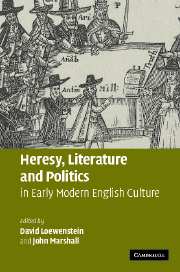Book contents
- Frontmatter
- Contents
- Acknowledgments
- Notes on contributors
- Introduction
- 1 Writing and the persecution of heretics in Henry VIII's England: The Examinations of Anne Askew
- 2 Anabaptism and anti-Anabaptism in the early English Reformation: defining Protestant heresy and orthodoxy during the reign of Edward VI
- 3 “Godlie matrons” and “loose-bodied dames”: heresy and gender in the Family of Love
- 4 Puritanism, Familism, and heresy in early Stuart England: the case of John Etherington revisited
- 5 A ticklish business: defining heresy and orthodoxy in the Puritan revolution
- 6 Thomas Edwards's Gangraena and heresiological traditions
- 7 “And if God was one of us”: Paul Best, John Biddle, and anti-Trinitarian heresy in seventeenth-century England
- 8 The road to George Hill: the heretical dynamic of Winstanley's early prose
- 9 Milton and the heretical priesthood of Christ
- 10 An Historical Narration Concerning Heresie: Thomas Hobbes, Thomas Barlow, and the Restoration debate over “heresy”
- 11 Defining and redefining heresy up to Locke's Letters Concerning Toleration
- 12 “Take heed of being too forward in imposinge on others”: orthodoxy and heresy in the Baxterian tradition
- Index
3 - “Godlie matrons” and “loose-bodied dames”: heresy and gender in the Family of Love
Published online by Cambridge University Press: 20 February 2010
- Frontmatter
- Contents
- Acknowledgments
- Notes on contributors
- Introduction
- 1 Writing and the persecution of heretics in Henry VIII's England: The Examinations of Anne Askew
- 2 Anabaptism and anti-Anabaptism in the early English Reformation: defining Protestant heresy and orthodoxy during the reign of Edward VI
- 3 “Godlie matrons” and “loose-bodied dames”: heresy and gender in the Family of Love
- 4 Puritanism, Familism, and heresy in early Stuart England: the case of John Etherington revisited
- 5 A ticklish business: defining heresy and orthodoxy in the Puritan revolution
- 6 Thomas Edwards's Gangraena and heresiological traditions
- 7 “And if God was one of us”: Paul Best, John Biddle, and anti-Trinitarian heresy in seventeenth-century England
- 8 The road to George Hill: the heretical dynamic of Winstanley's early prose
- 9 Milton and the heretical priesthood of Christ
- 10 An Historical Narration Concerning Heresie: Thomas Hobbes, Thomas Barlow, and the Restoration debate over “heresy”
- 11 Defining and redefining heresy up to Locke's Letters Concerning Toleration
- 12 “Take heed of being too forward in imposinge on others”: orthodoxy and heresy in the Baxterian tradition
- Index
Summary
In the years around 1580, a feeling was growing amongst England's more zealous Protestants that the most terrifying threat to truth came no longer from the Catholics but from the Family of Love, “a deadly heresie of all others.” The Family's enemies sounded the alarum for a new battle in the old war between heresy and truth, and they discussed the subject in the starkest of theological terms. Followers of the Family's Dutch founder, H. N. or Hendrick Niclaes, were fiercely criticized for each of their central tenets: that “good-willing” humans could reach a state in which they were inhabited by divinity, or “godded with God” that in this state, sin was vanquished and perfection attained; and that much of scripture was to be interpreted allegorically. Such heresies, in association with the Family's controversial belief in the legitimacy of dissembling before hostile inquisitors, opened “a very window” to all manner of other dangers. Through this window, John Knewstub and others peered anxiously at the dark prospect of a Familist future, marked by “the overthrow of the common wealth,” “lewdnesse of life,” and “a monstrous new kind of speech never found in the scriptures.”
In practice, however, the perils of heresy were not as black and white as this. All heresies were connected with one another in the eternal battle, but some were worse than others. Orthodoxy and its opposites were very much in the eye of the beholder.
- Type
- Chapter
- Information
- Publisher: Cambridge University PressPrint publication year: 2006

